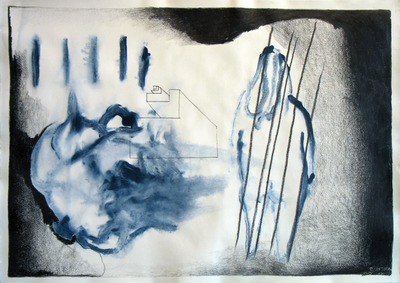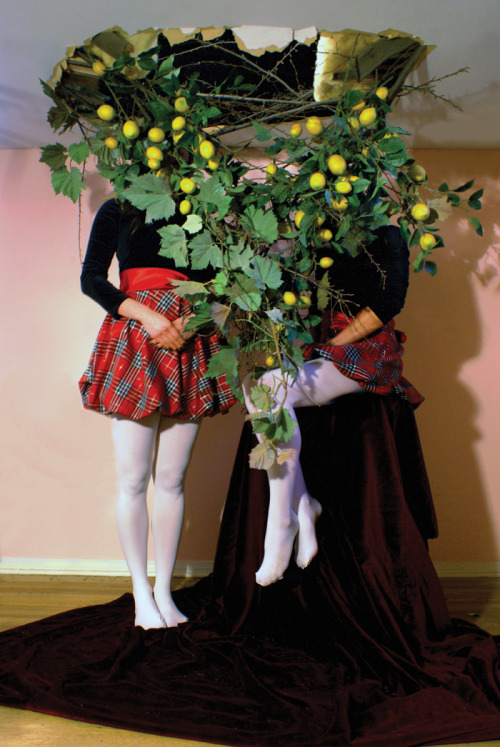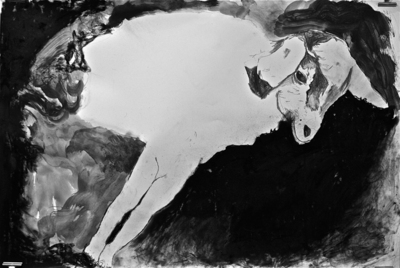Pink Collar Glam
By Travis Egedy
 Chaos Study by Tiffany KennedyIt seems there may be something of a feminist (feminine?) revolution bubbling under the surface of Denver’s artistic communities. In last month’s VOICE, I wrote about the no holds barred Titwrench music festival, a local festival of progressive female music and culture that is run and operated by a group of strong, independent women. The festival is an all-inclusive look into contemporary feminist culture and the sounds that go along with it.
Chaos Study by Tiffany KennedyIt seems there may be something of a feminist (feminine?) revolution bubbling under the surface of Denver’s artistic communities. In last month’s VOICE, I wrote about the no holds barred Titwrench music festival, a local festival of progressive female music and culture that is run and operated by a group of strong, independent women. The festival is an all-inclusive look into contemporary feminist culture and the sounds that go along with it.
As it turns out, this creative energy by groups of women is not just limited to the underground music community, and I was compelled to write about some women who are making similar strides in the underground visual art scene in Denver. These women are a loose collective that call themselves “Pink Collar Glam,” taking their name from the “Pink Collar Army,” who were a group of working class women responding to the idea of “glamour” in the 18th century.
Similar to Titwrench, these women decided to create something where they saw a void, which was the lack of women showing contemporary artwork in Denver’s art scene. Pink Collar Glam has so far only put on two exhibitions in Denver, but it is already apparent that they are on to something special. I sat down outside of a noisy bar in the RINO art district on July 5th to interview members of Pink Collar Glam, while a family was setting off an enormous amount of very large fireworks, which turned out to be more than a little disruptive to the interview (a plastic fence caught on fire.) Watching and dodging the fireworks with me were the group’s four core members, Chrissy Espinoza, Christine Buchsbaum, Tiffany Kennedy, and Holly Johnson.
Travis Egedy: So, how did you all meet? And how did Pink Collar Glam begin?
Holly Johnson: I think we all met in school, at RMCAD [Rocky Mountain College of Art and Design].
Tiffany Kennedy: Actually, I met Christine at Rhinoceropolis. We started hanging out and talking about putting together a group of women artists and showing.
TE: Really? When was that?
Christine Buchsbaum: It was actually after your “Down With The Sickness” art show at Hinterland Gallery. I think you said it just so happened to be all men in the show, and we were like, fuck this, why don’t we put together a collective of all female artists who are making progressive work? Not even because they are all female, but just because it would provide an outlet for that.
Tiffany Kennedy: And we kind of felt like that, even in the nicer galleries around Denver, the work that was getting shown by female artists wasn’t very progressive at all, it was just marketable. Work to sell.
Holly Johnson: And it was all older women; there was no one our age. Women who were much older who were very established, and hadn’t even necessarily started in Denver.
TE: Yeah, do you think it is harder to be a progressive young female artist in Denver as opposed to a male?
Christine: Well, yeah, if you aren’t making work that is marketable. It’s a lot harder. Its not like New York or L.A.
Chrissy Espinoza: In L.A. for example feminists had already established those female legions of artists, in the 60’s. They already did a female movement headed by Judy Chicago.
Christine: We said we weren’t going to mention Judy Chicago! (all laugh)
Holly: But yeah, Denver hasn’t had a female art movement whatsoever, that we know about.
 Untitled Work by Christine Buchsbaum
Untitled Work by Christine Buchsbaum
TE: So you all wanted to start that? You wanted to start something important?
All in unison: Yeah, totally.
TE: So why the name Pink Collar Glam?
Christine: Pink collar is basically like the traditional jobs that women had. Like blue collar, but pink. Female working class.
Tiffany: The idea of glamour came from the working class women, because femininity was something that only rich women had. To them, glamour was something sexy and cool and allowed them to be kind of on the same level. Especially now its become…
(Some pops) (huge boom) (screams)
Christine: Oh my god! Shit!
Some guy: Hey there is a fire over there!
Holly: FIRE!
Tiffany: Well this is an exciting interview.
(All watch as the fire is stamped out by children)
TE: Okay um, when you guys were all in art school at RMCAD, did you learn about feminism there? Or did you teach yourselves from personal interest?
Chrissy: I think at RMCAD most of my professors were all male, and I was an animation student, so it wasn’t really talked about.
Tiffany: I took a class called Women In Western Heritage, it was really good to learn about all these obscure women in history who were just as good as the males, but didn’t get the recognition.
Christine: I feel like going to RMCAD made me a feminist! I remember one piece where a fellow female classmate, as a piece of art, stood in front of the class and just started peeing. I think she was wearing a dress. And I was so mad about that! It wasn’t about equality; it was about her trying to be like a man and pee. And that pissed me off.
TE: You didn’t like the piece?
Christine: No I hated it, because it was not holding herself as a woman.
Tiffany: Christine and I were talking about feminism in the 70’s as being so angry and trying to be more like a man, very masculine. We think feminism should embrace femininity more. And not try to be so dominant, but being comfortable with the fact that we are women.
TE: Yeah, that wave of feminism in the 60’s and 70’s was somewhat of a failure because it was too angry and reactionary. It doesn’t make sense to counteract oppression by trying to re-oppress something else. Like punching someone in the face after they punch you in the face; it may feel good, but nothing is gained and it doesn’t move anything forward. Just embracing who you are is more radical I think.
Holly: Yeah just be yourself. Be a woman.
(more big booms)
Holly: I don’t think I have ever seen fireworks this close before!
Christine: That is what I am afraid of!
TE: Do you think it is harder to be a woman in the art world on a local or international level?
Christine: Locally I feel that way, but not internationally.
Holly: Yeah, people who don’t know a lot about art just think about art in Denver as the Santa Fe art walk, and we want to change that and show that it is more than that.
TE: So you do think it is harder?
Christine: I don’t even think it is about female artists not being seen, it is just artists who are not making work for money, or for commercial reasons; they wont get any attention. It is obviously harder to get more avant-garde work seen by people who don’t already have an interest in it.
Tiffany: In the high art realm, women are getting just as much attention, if not more than men right now. But there isn’t much high art in Denver.
TE: Can you talk about the past shows you have done?
Tiffany: We have had two. The first one was in February at Andenken Gallery. We all made one specific piece each. We wanted it to just be an introduction into who we are and what we are about.
TE: Who all was in that show?
Christine: It was the four of us, Alicia Ordal and Rhianna Brown.
TE: So Pink Collar Glam is a loose collective then? You guys as core members, but it is open?
Tiffany: Yeah it is just a matter of meeting new people who are doing cool things.
TE: Has it been hard to find support or get shows?
Christine: Uh yeah, extremely fucking hard. I remember the artist, Phil Bender, saying that he couldn’t believe that we were starting [an] all female collective because it had been done so much in the 60’s, and that it was a stupid idea. But there was some support for sure.
Tiffany: I don’t think it has anything to do with us specifically. It is just how it goes. The week and a half before our first show, the gallery owners got evicted, so we had to scramble just to find a new gallery. We were lucky to find Andenken.
(huge explosions, and a brick of black cats that goes off for around 4 minutes)
TE: So how do you hope to affect the Denver art scene?
Christine: I hope it brings more of an audience to what the more progressive and younger artists are doing. I want people to see it. There isn’t really a template for that, unless it is a place like Rhinoceropolis, or Pirate gallery, and a few other spots. But if you aren’t in the know, you don’t really know about those places, or care. We want to change that.
TE: So you just want to broaden everyone’s horizons to more cutting edge art?
Tiffany: I just want talented female artists in Denver to be noticed and represented. That is the main thing.
TE: Would you call what Pink Collar Glam does “feminism,” or is it simply about celebrating female talent?
Tiffany: It is hard to label something as feminism because that word carries so much weight. It almost implies anger or hatred towards men, but it should just be about being equal. It’s just a way of expressing ourselves, and celebrating our friends.
TE: So what’s next for Pink Collar Glam?
Christine: Probably a show in late September or October. It will probably be much smaller, and more concise as to who we are as a collective. There will be a theme.
Holly: Yeah, we just want to establish ourselves and our goal. And not have it as open as the last show we did.
Christine: We all have work in shows coming up.
Tiffany: I don’t.
(A collective sad sound, then laughter)
Christine: Well you are quitting smoking; that is a show in itself.
TE: Has Denver received what you are doing well?
Holly: Yeah totally. It is pretty exciting. And it is the perfect place. It is small enough for us to be doing this, and for us to be a collective force in the art community. This idea hasn’t happened here yet, so we can start fresh.
To view more of the artist’s work
< www.Christinebuchsbaum.com >
< www.tiffanykennedy.com >
< chrissyespinoza.carbonmade.com >

